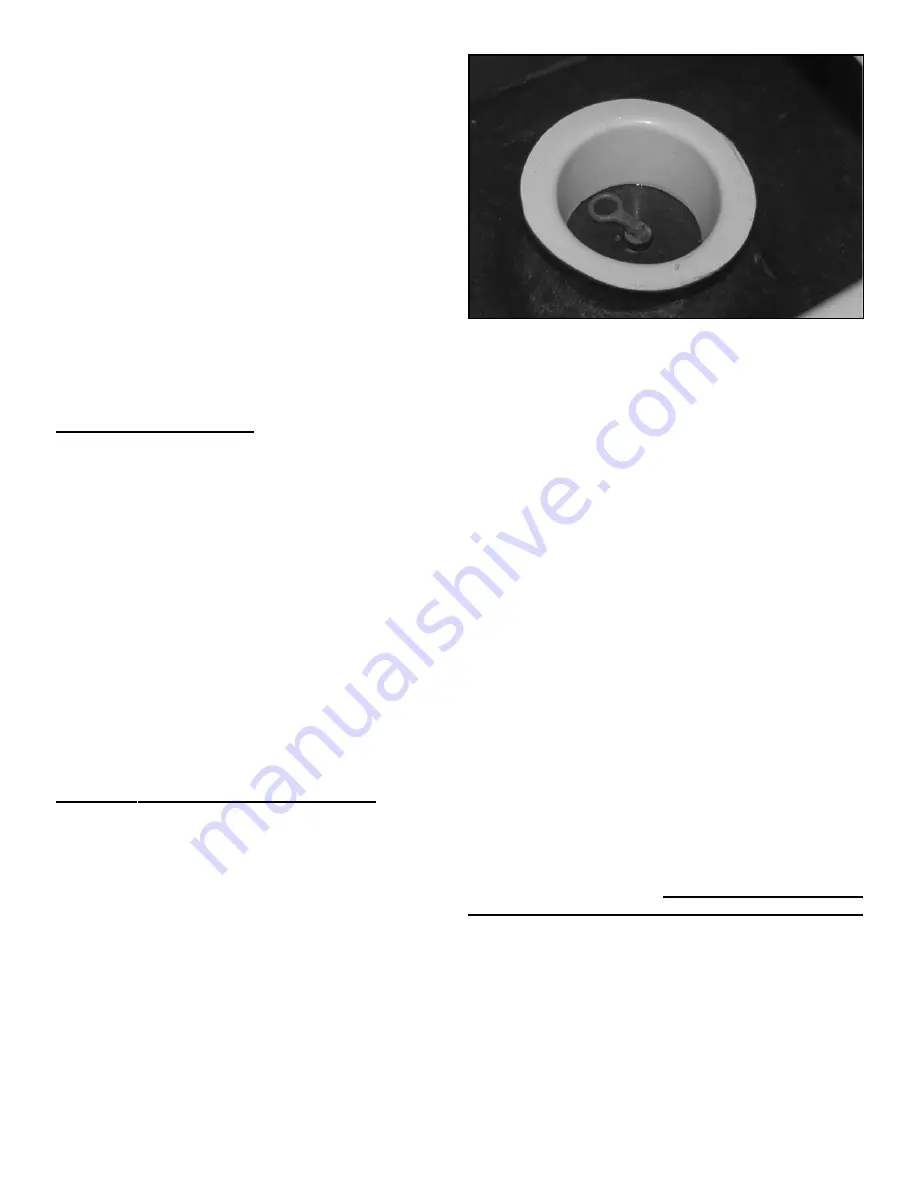
forward of a straight line drawn from the top of the mast to the
base of the mast. The downwind wires will be somewhat slack
when sailing hard. When sailing into the wind, the mainsail takes
over the task of supporting the mast from the rear.
SECURE ALL COTTER PINS AND RINGS.
Make sure all
the cotter pins and rings are in place and the cotter pins are opened
and secured. Once again, the ring dings should be fully on the pin,
so they can be rotated freely 360 degrees without coming out of
the hole in the pin. Wrap them with electrical tape so they can’t
come loose.
INSPECTION OF THE RIGGING.
It is a good idea to period-
ically inspect the mast and rigging. Look for broken strands in the
wire bundles, signs of wear, and for kinks in the wire. Inspect the
nicopress fittings to make sure the wire hasn’t slipped through the
fittings. Replace any damaged wire.
RAMP LAUNCHING
Remove the trailer lights. Attach a 15’ line to the nose of the boat.
Back the trailer into the water until the boat floats free. Do not
untie the nose of the boat from the trailer winch until the boat is
in the water. On a reasonably steep ramp, the boat could slide off
the trailer before it gets near the water. This is a good way to look
really stupid. If you leave the car for any reason, make sure the
brake is well set, or the whole works may end up under water.
This will look even worse.
Make sure the rudder and the outboard motor are secure in the full
up position so they won’t hit the ground when launching and
recovering the boat.
After launching, go inside to make sure there are no leaks. If you
raise the mast after the boat is in the water, first fill the water bal-
last tank to give yourself a more stable platform.
THE WATER BALLAST SYSTEM
FILLING THE BALLAST TANK.
The water ballast tank has a
vent that allows air to escape when the tank is being filled. It is
also used to allow air to enter as the tank is being emptied.
Normally, this vent is sealed except when the tank is being emp-
tied or filled. It is located directly under the hatch at the rear end
of the forward V berth. Lift up the V berth cushion, remove the
wood hatch cover, and the vent will be visible. It is surrounded
by a fiberglass dam that helps keep water from sloshing out of the
vent hole and into the bilge of the boat.
The vent hole also allows you to check the level of the water in
the ballast tank. (There will be more on this subject later in these
instructions.)
The following photograph shows the vent with its plug installed.
Vent hole and plug
FILLING THE TANK.
To fill the tank, first open the air vent by
removing the lever plug shown in the above photo. Then open the
gate valve on the transom by pulling upward on the valve handle.
This handle is located just to the left of the engine (as you face
aft). Remember to close it after filling the tank. The following
shows the approximate time needed to fill the tank with the boat
in the water.
With 50 hp Tohatsu and 70 lbs of fuel:
5 minutes
With one 170 lb. person, no motor or fuel:
8 minutes
With no motor, fuel or crew:
18+ minutes
The more weight in the boat, the faster it will fill, because the
valve is more deeply submerged. With no motor or crew, the
valve is about 40 % under water, and the fill is really slow.
However, there is almost always a crew member or a motor. Keep
the weight aft to make sure the transom valve is under water.
You can empty the tank underway. With the vent and transom
valves open, and the boat going about 7 mph, the tank will drain
in about 4 minutes.
At a sloped standard launch ramp, with the boat on its trailer and
out of the water, the tank will drain in 3 minutes. When you open
the valve, get out of the way, because the water comes out like
from a fire hose.
CHECKING THE LEVEL OF THE TANK.
When the tank is
full, and with the boat level, the water level in the tank is approx-
imately 1” below the vent hole.
If it is more than 1” down from
the vent hole, the boat may not be self righting. Do not sail it.
There is a 16” long clear plastic tube in the rig box. Stick this in
the vent hole, push it to the bottom of the boat and put your finger
over the top end of the tube. Keep the tube top sealed tight and
lift out the tube. The water level in the tank will show in the tube.
CLOSING THE WATER VALVE AND AIR VENT.
Re-install
the lever plug in the vent hole. Make sure it is tight, or the water
ballast will spill into the boat when the boat leans over. There is
an adjustment nut at the bottom of the lever plug. If the plug is
too loose, hold the metal parts at the top and turn the rubber. The
Page 12
Содержание 26 M 2009
Страница 28: ...Page 28...



























